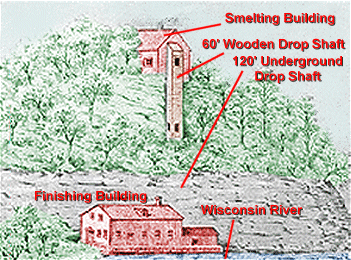|
Twenty years before
Wisconsin
became a state, the discovery of
vast lead deposits brought a population boom to the area.
Green Bay
merchant Daniel Whitney
organized the Wisconsin Shot Company to built a shot tower.
One of the most unique shot towers in the world was built between 1831 and
1833 in
Helena
, Wisconsin
. The location has special significance in
Wisconsin
history as the site of the lead
region
village
of
Helena
and the place where
Green Bay
entrepreneur, Daniel Whitney, and his partner, T. B. Shaunce built
a tower to make lead shot. This is not your classic shot tower, one that
rises several hundred feet with the whole operation above ground, similar
to the
Phoenix
Tower
in
Baltimore
or the
Sparks
Tower
in
Philadelphia
. This tower was basically a deep
shaft in the ground from a smelting house near the top of a cliff above
the
Wisconsin River
and a finishing house near the
base. The shaft was hand dug by Whitney and Shaunce with pick and gag (pry
bar) and removed the earth with buckets. Men like Whitney and Shaunce
worked with humble tools and crude methods.
Wisconsin
. The location has special significance in
Wisconsin
history as the site of the lead
region
village
of
Helena
and the place where
Green Bay
entrepreneur, Daniel Whitney, and his partner, T. B. Shaunce built
a tower to make lead shot. This is not your classic shot tower, one that
rises several hundred feet with the whole operation above ground, similar
to the
Phoenix
Tower
in
Baltimore
or the
Sparks
Tower
in
Philadelphia
. This tower was basically a deep
shaft in the ground from a smelting house near the top of a cliff above
the
Wisconsin River
and a finishing house near the
base. The shaft was hand dug by Whitney and Shaunce with pick and gag (pry
bar) and removed the earth with buckets. Men like Whitney and Shaunce
worked with humble tools and crude methods.
The energetic Yankee entrepreneur who had come to
Green Bay
in the 1820s, Whitney delved into a wide variety of potentially
profitable ventures – lumbering on the upper
Wisconsin
, fur trading, and town-site
speculation. He formed a business partnership to manufacture lead shot in
1830 at a time when
Wisconsin
had no shot tower and he hoped
to market lead in the East. Construction began in 1831 and was completed
in 1833, having been interrupted by the Black Hawk War.
The
Shot Tower
The shot tower operated intermittently under various owners from 1833
until 1861. Shot making involved a (1)
smelting house at the top of the cliff, (2)
the 60 foot wooden shot tower shaft itself at the top of the sandstone
cliff, (3)
a 120-foot shaft cut through the rock beneath the wooden tower, (4)
and a 90-foot access tunnel leading to a finishing house beside the
Wisconsin River.
The shot drop was a total of 180 feet including a 60 foot wood shaft and a
120 foot underground shaft to the base. The shot was removed through a
horizontal 90 foot shaft to daylight along the
Wisconsin River
to a finishing house.
Molten lead poured into a perforated ladle, dropped 180 feet, and formed
shot as it fell, landing in a pool of water at the bottom of the shaft.
Cooled shot was loaded into horse-drawn railcars and drawn through the
tunnel to the finishing house for drying and polishing. The tower could
produce 5,000 pounds of shot per day.
Then it was loaded aboard boats on the
Wisconsin River
which at that time flowed past
the base of the bluff.
Helena
was a sufficiently prosperous
mining community in 1836 to make a serious bid for the territorial
capital. When in 1856 Spring Green secured the railroad connection and
Helena
was bypassed, it began to wither
in the ensuing depression of the late 1850s.
Foundations of the
Helena
buildings still remain in the
Tower
Hill
State Park
near Spring Green,
Wisconsin
. The mining community of
Helena
is long gone.
| 

